A Comprehensive Review of Soil Remolding Toughness Determination and Its Use in the Classification of Fine-Grained Soils
Abstract
:1. Introduction
2. Soil Remolding Toughness Measurement
2.1. Barnes’ Thread Rolling Apparatus and Method
2.2. Proposed Extrusion Approaches
2.2.1. Extrusion and Remolding Toughness
2.2.2. Power-Based Approaches for Consistency Limits Determination
3. Quantitative Assessment of Tmax (after Moreno-Maroto and Alonso-Azcárate [11])
4. Correlating Tmax with the Consistency Limits
5. Distinguishing between Clay and Silt Soils Based on the Value of Tmax
6. Toughness-Based Classification of Fine-Grained Soils
7. Advantages/Limitations of the Existing Methods for Toughness Determination
8. Recommendations on Future Research Efforts for Soil Toughness Determination
9. Summary and Conclusions
Author Contributions
Funding
Data Availability Statement
Conflicts of Interest
Abbreviations
| CE | clay of extremely high plasticity |
| CH | clay of high plasticity |
| CI | clay of intermediate plasticity |
| CL | clay of low plasticity |
| CV | clay of very high plasticity |
| DE | direct extrusion |
| MCV | moisture condition value |
| MFI | Martin flow instrument |
| MH | silt of high plasticity |
| ML | silt of low plasticity |
| MV | silt of very high plasticity |
| RE | reverse extrusion |
| SSA | specific surface area |
| SSI | soil state index |
| Notations | |
| e0 | initial void ratio |
| Do | billet diameter |
| Fe | ram/die force |
| IF | flow index |
| IL | liquidity index |
| IP | plasticity index |
| IT(B) | toughness index (after Barnes) |
| IT(C) | toughness index (after Casagrande) |
| IW | workability index (after Barnes) |
| L | initial length of billet |
| n | number of observations or data points |
| N | number of blows |
| pe | extrusion pressure |
| pe(PL) | extrusion pressure at plastic limit water content |
| PL100 | plastic strength limit |
| R2 | coefficient of determination |
| su | undrained shear strength |
| T | remolding toughness |
| Tmax | maximum remolding toughness (at wP water content) |
| Ts | remolding toughness at stiffness transition water content |
| w | water content |
| wL | liquid limit water content |
| wL-FC | fall-cone liquid limit water content |
| wP | plastic limit water content |
| wS | stiffness transition |
| wT | toughness limit |
| σ | standard deviation |
References
- Atterberg, A. Die plastizität der tone. Internationale Mitteilungen Bodenkunde 1911, 1, 4–37. [Google Scholar]
- Atterberg, A. Lerornas forhållande till vatten, deras plasticitetsgränser och plasticitetsgrader. Kungliga Lantbruksakademiens Handlingar och Tidskrift 1911, 50, 132–158. [Google Scholar]
- ASTM D4318-17e1; Standard Test Methods for Liquid Limit, Plastic Limit, and Plasticity Index of Soils. ASTM International: West Conshohocken, PA, USA, 2017.
- BS EN ISO 17892-12:2018+A2:2022; Geotechnical Investigation and Testing. Laboratory Testing of Soil. Part 12: Determination of Liquid and Plastic Limits. British Standards Institution: London, UK, 2022.
- Bobrowski, L.J.; Griekspoor, D.M. Determination of the plastic limit of a soil by means of a rolling device. Geotech. Test. J. 1992, 15, 284–287. [Google Scholar] [CrossRef]
- AASHTO T90; Standard Method of Test for Determining the Plastic Limit and Plasticity Index of Soils. American Association of State Highway and Transportation Officials (AASHTO): Washington, DC, USA, 2020.
- Soltani, A.; O’Kelly, B.C. Reappraisal of the ASTM/AASHTO standard rolling device method for plastic limit determination of fine-grained soils. Geosciences 2021, 11, 247. [Google Scholar] [CrossRef]
- Barnes, G.E. The Plastic Limit and Workability of Soils. Ph.D. Thesis, University of Manchester, Manchester, UK, 2013. [Google Scholar]
- O’Kelly, B.C.; Moreno-Maroto, J.M.; Alonso-Azcárate, J. Discussion of “Determining Soil Plasticity Utilizing Manafi Method and Apparatus” by Masoud S. G. Manafi, An Deng, Abbas Taheri, Mark B. Jaksa, and Nagaraj HB, published in 45, no. 4 (2022): 797–818. Geotech. Test. J. 2022, 45, 1144–1150. [Google Scholar] [CrossRef]
- Prakash, K.; Sridharan, A. Critical appraisal of the cone penetration method of determining soil plasticity. Can. Geotech. J. 2006, 43, 884–888. [Google Scholar] [CrossRef]
- Moreno-Maroto, J.M.; Alonso-Azcárate, J. What is clay? A new definition of “clay” based on plasticity and its impact on the most widespread soil classification systems. Appl. Clay Sci. 2018, 161, 57–63. [Google Scholar] [CrossRef]
- O’Kelly, B.C. Reappraisal of soil extrusion for geomechanical characterisation. Geotech. Res. 2019, 6, 265–287. [Google Scholar] [CrossRef]
- O’Kelly, B.C. Appraisal of novel power-based extrusion methodology for consistency limits determinations of fine-grained soils. In Proceedings of the Civil Engineering Research in Ireland 2022 Conference, Dublin, Ireland, 25–26 August 2022; Holmes, N., de Paor, C., West, R.P., Eds.; Civil Engineering Research Association of Ireland: Dublin, Ireland, 2022; Volume 1, pp. 317–322. [Google Scholar]
- Casagrande, A. Classification and identification of soils. Proc. Am. Soc. Civ. Eng. 1947, 73, 783–810. [Google Scholar] [CrossRef]
- ASTM D2487-17; Standard Practice for Classification of Soils for Engineering Purposes (Unified Soil Classification System). ASTM International: West Conshohocken, PA, USA, 2017.
- BS EN ISO 14688-2:2017; Geotechnical Investigation and Testing—Identification and Classification of Soil. Part 2: Principles for a Classification. British Standards Institution: London, UK, 2017.
- Barnes, G.E. An apparatus for the plastic limit and workability of soils. Proc. Inst. Civ. Eng.—Geotech. Eng. 2009, 162, 175–185. [Google Scholar] [CrossRef]
- Barnes, G.E. An apparatus for the determination of the workability and plastic limit of clays. Appl. Clay Sci. 2013, 80–81, 281–290. [Google Scholar] [CrossRef]
- O’Kelly, B.C.; Vardanega, P.J.; Haigh, S.K. Use of fall cones to determine Atterberg limits: A review. Géotechnique 2018, 68, 843–856. [Google Scholar] [CrossRef]
- Haigh, S. Consistency of the Casagrande liquid limit test. Geotech. Test. J. 2016, 39, 13–19. [Google Scholar] [CrossRef]
- O’Kelly, B.C. Fallacy of wide undrained strength range at the Casagrande liquid limit. Geotech. Res. 2019, 6, 205–217. [Google Scholar] [CrossRef]
- Haigh, S.K.; Vardanega, P.J.; Bolton, M.D. The plastic limit of clays. Géotechnique 2013, 63, 435–440. [Google Scholar] [CrossRef]
- O’Kelly, B.C.; Vardanega, P.J.; Haigh, S.K. Discussion of “Mohajerani method: Tool for determining the liquid limit of soils using fall cone test results with strong correlation with the Casagrande test” by E. Hrubesova, B. Lunackova and M. Mohyla [Engineering Geology 278 (2020) 105852]. Eng. Geol. 2022, 302, 106623. [Google Scholar] [CrossRef]
- O’Kelly, B.C.; Soltani, A. Machine learning techniques for relating liquid limit obtained by Casagrande cup and fall cone test in low-medium plasticity fine grained soils [Eng. Geol. (2021) 294, 106381]. Eng. Geol. 2022, 306, 106746. [Google Scholar] [CrossRef]
- Sivakumar, V.; O’Kelly, B.C.; Henderson, L.; Moorhead, C.; Chow, S.H. Measuring the plastic limit of fine soils: An experimental study. Proc. Inst. Civ. Eng.—Geotech. Eng. 2015, 168, 53–64. [Google Scholar] [CrossRef]
- O’Kelly, B.C. Discussion of “Advancement in estimation of undrained shear strength through fall cone tests” by Abhishek Ghosh Dastider, Santiram Chatterjee, and Prasenjit Basu. J. Geotech. Geoenviron. Eng. 2022, 148, 07022005. [Google Scholar] [CrossRef]
- Sivakumar, V.; O’Kelly, B.C.; Henderson, L.; Moorhead, C.; Chow, S.H.; Barnes, G.E. Discussion: Measuring the plastic limit of fine soils: An experimental study. Proc. Inst. Civ. Eng.—Geotech. Eng. 2016, 169, 83–85. [Google Scholar] [CrossRef]
- O’Kelly, B.C. Review of recent developments and understanding of Atterberg limits determinations. Geotechnics 2021, 1, 59–75. [Google Scholar] [CrossRef]
- Soltani, A.; O’Kelly, B.C. Reappraisal of fall-cone flow curve for soil plasticity determinations. Geotech. Test. J. 2022, 45, 225–243. [Google Scholar] [CrossRef]
- O’Kelly, B.C.; Soltani, A. Discussion: Determining the plasticity properties of high plastic clays: A new empirical approach [Arab J Geosci (2020) 13(11), 394]. Arab. J. Geosci. 2021, 14, 715. [Google Scholar] [CrossRef]
- Moreno-Maroto, J.M.; Alonso-Azcárate, J. Plastic limit and other consistency parameters by a bending method and interpretation of plasticity classification in soils. Geotech. Test. J. 2017, 40, 467–482. [Google Scholar] [CrossRef]
- Vardanega, P.J.; Haigh, S.K.; O’Kelly, B.C. Use of fall-cone flow index for soil classification: A new plasticity chart. Géotechnique 2022, 72, 610–617. [Google Scholar] [CrossRef]
- Sherwood, P.T. The Reproducibility of the Results of Soil Classification and Compaction Tests; Transport and Road Research Laboratories Report LR 339; Department of Transport: London, UK, 1970. [Google Scholar]
- O’Kelly, B.C. Atterberg limits are not appropriate for peat soils. Geotech. Res. 2015, 2, 123–134. [Google Scholar] [CrossRef]
- Vardanega, P.J.; Haigh, S.K.; O’Kelly, B.C.; Zhang, X.; Liu, X.; Chen, C.; Wang, G. Discussion: Use of fall-cone flow index for soil classification: A new plasticity chart. Géotechnique 2023. ahead of print. [Google Scholar] [CrossRef]
- Casagrande, A. Research on the Atterberg limits of soils. Public Roads 1932, 13, 121–136. [Google Scholar]
- Wasti, Y.; Bezirci, M.H. Determination of the consistency limits of soils by the fall-cone test. Can. Geotech. J. 1986, 23, 241–246. [Google Scholar] [CrossRef]
- O’Kelly, B.C. Atterberg limits and remolded shear strength–water content relationships. Geotech. Test. J. 2013, 36, 939–947. [Google Scholar] [CrossRef]
- Vardanega, P.J.; Haigh, S.K. The undrained strength–liquidity index relationship. Can. Geotech. J. 2014, 51, 1073–1086. [Google Scholar] [CrossRef]
- ASTM D2488-17e1; Standard Practice for Description and Identification of Soils (Visual-Manual Procedures). ASTM International: West Conshohocken, PA, USA, 2017.
- Soil Science Division Staff. Chapter 3—Examination and description of soil profiles. In Soil Survey Manual—United States Department of Agriculture Handbook 18; Ditzler, C., Scheffe, K., Monger, H.C., Eds.; Government Printing Office: Washington, DC, USA, 2017. Available online: https://www.nrcs.usda.gov/wps/portal/nrcs/detail/soils/ref/?cid=nrcs142p2_054261 (accessed on 22 July 2022).
- Naval Facilities Engineering Command (NAVFAC). Soil Mechanics Design Manual 7.01; Naval Facilities Engineering Command: Alexandria, VA, USA, 1986. [Google Scholar]
- Astbury, N.F.; Moore, F.; Lockett, J.A. A cyclic torsion test for study of plasticity. Trans. J. Br. Ceram. Soc. 1966, 65, 435–461. [Google Scholar]
- ASTM C181-11; Standard Test Method for Workability Index of Fireclay and High-Alumina Refractory Plastics. ASTM International: West Conshohocken, PA, USA, 2018.
- Parsons, A.W. Moisture condition test for assessing the engineering behaviour of earthwork material. In Proceedings of the Conference on Clay Fills, London, UK, 14–15 November 1978; Institution of Civil Engineers: London, UK, 1978; pp. 169–175. [Google Scholar] [CrossRef]
- Fitzjohn, W.H.; Worrall, W.E. Physical properties of raw brick clays. Trans. J. Br. Ceram. Soc. 1980, 79, 74–81. [Google Scholar]
- CERAM Research. Rheology Testing for Ceramics. Version Jun 12, 2001. Available online: https://www.azom.com/article.aspx?ArticleID=547 (accessed on 28 February 2023).
- Kessel, S. Ceramic rheology tester gets the thumbs up. Mater. World 1998, 16, 474–475. [Google Scholar]
- Manafi, M.S.G.; Deng, A.; Taheri, A.; Jaksa, M.B.; HB, N. Determining soil plasticity utilizing Manafi method and apparatus. Geotech. Test. J. 2022, 45, 797–818. [Google Scholar] [CrossRef]
- Moreno-Maroto, J.M.; Alonso-Azcárate, J.; O’Kelly, B.C. Review and critical examination of fine-grained soil classification systems based on plasticity. Appl. Clay Sci. 2021, 200, 105955. [Google Scholar] [CrossRef]
- Hanson, J.A.; Hardin, B.O.; Mahboub, K. Fracture toughness of compacted cohesive soils using ring test. J. Geotech. Eng. 1994, 120, 872–891. [Google Scholar] [CrossRef]
- Wang, J.J.; Zhu, J.G.; Chiu, C.F.; Zhang, H. Experimental study on fracture toughness and tensile strength of a clay. Eng. Geol. 2007, 94, 65–75. [Google Scholar] [CrossRef]
- Vinod, P.; Sreelekshmy Pillai, G. Toughness limit: A useful index property for prediction of compaction parameters of fine grained soils at any rational compactive effort. Indian Geotech. J. 2017, 47, 107–114. [Google Scholar] [CrossRef]
- Shimobe, S.; Karakan, E.; Sezer, A. Evaluation of dependency of compression index on toughness limit for fine-grained soils. Neural Comput. Appl. 2023, 35, 11183–11205. [Google Scholar] [CrossRef]
- O’Kelly, B.C. Discussion of “Strength and consolidation characteristics for cement stabilized cohesive soil considering consistency index” by Ahmed, F. Zidan, published in Geotechnical and Geological Engineering, https://doi.org/10.1007/s10706-020-01367-6. Geotech. Geol. Eng. 2021, 39, 4659–4662. [Google Scholar] [CrossRef]
- Haigh, S.K.; O’Kelly, B.C.; Vardanega, P.V. Discussion of “Determining soil plasticity utilizing Manafi method and apparatus” by Masoud, S. G. Manafi, An Deng, Abbas Taheri, Mark B. Jaksa, and Nagaraj HB, published in Geotechnical Testing Journal 45, no. 4 (2022): 797–818. Geotech. Test. J. 2023, 46. [Google Scholar] [CrossRef]
- Shimobe, S.; Spagnoli, G. Some generic trends on the basic engineering properties of fine-grained soils. Environ. Earth Sci. 2019, 78, 281. [Google Scholar] [CrossRef]

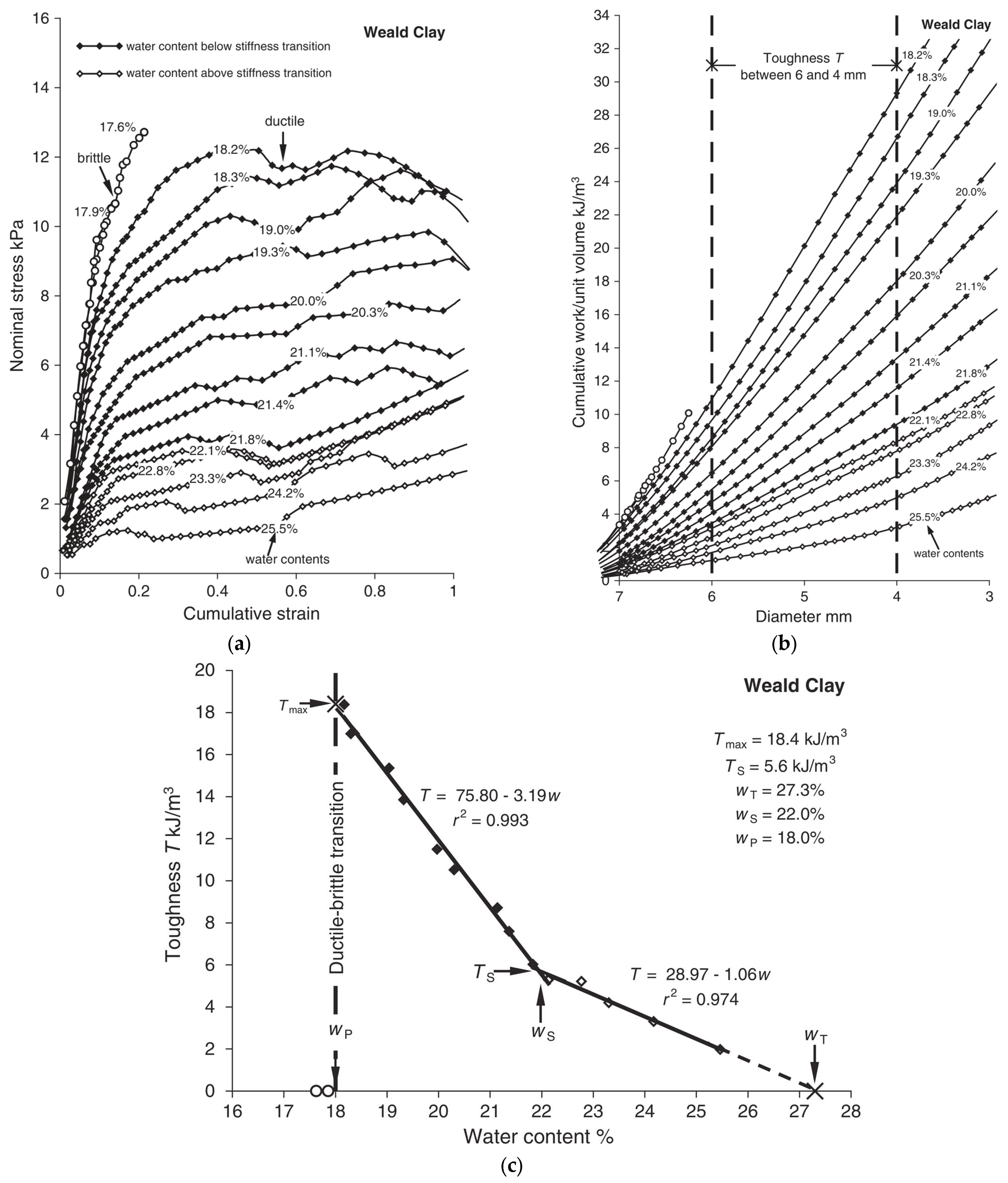

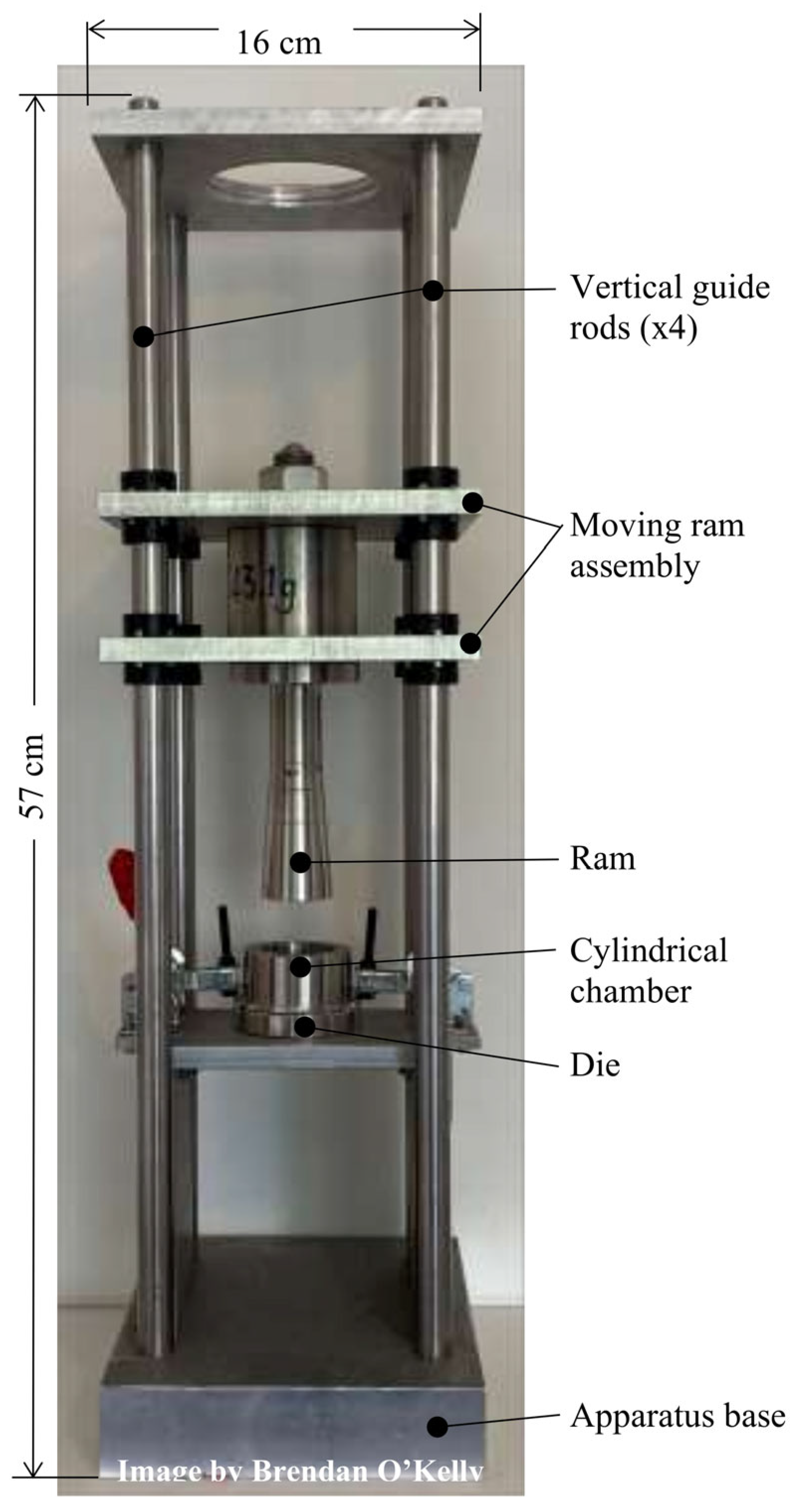
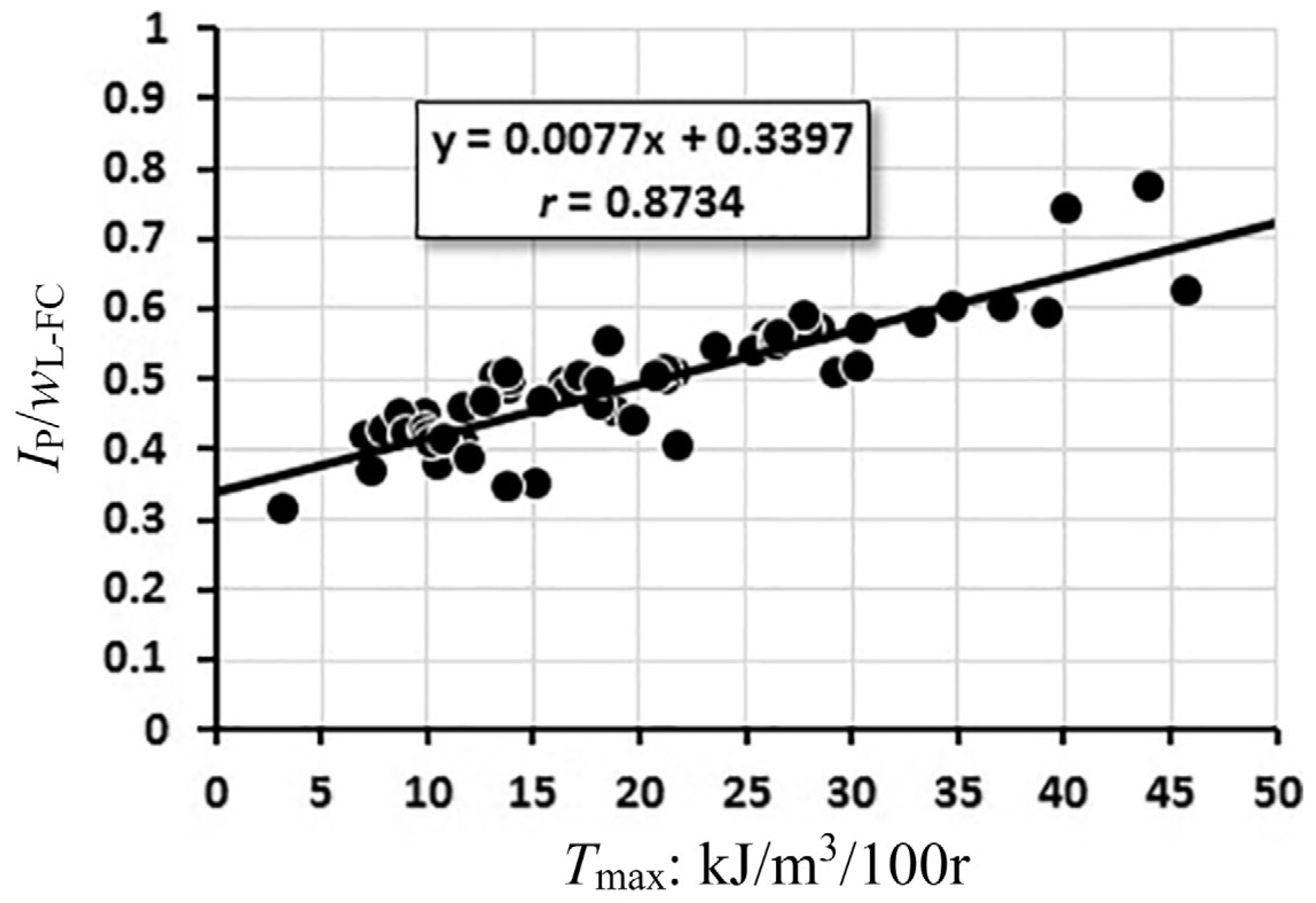
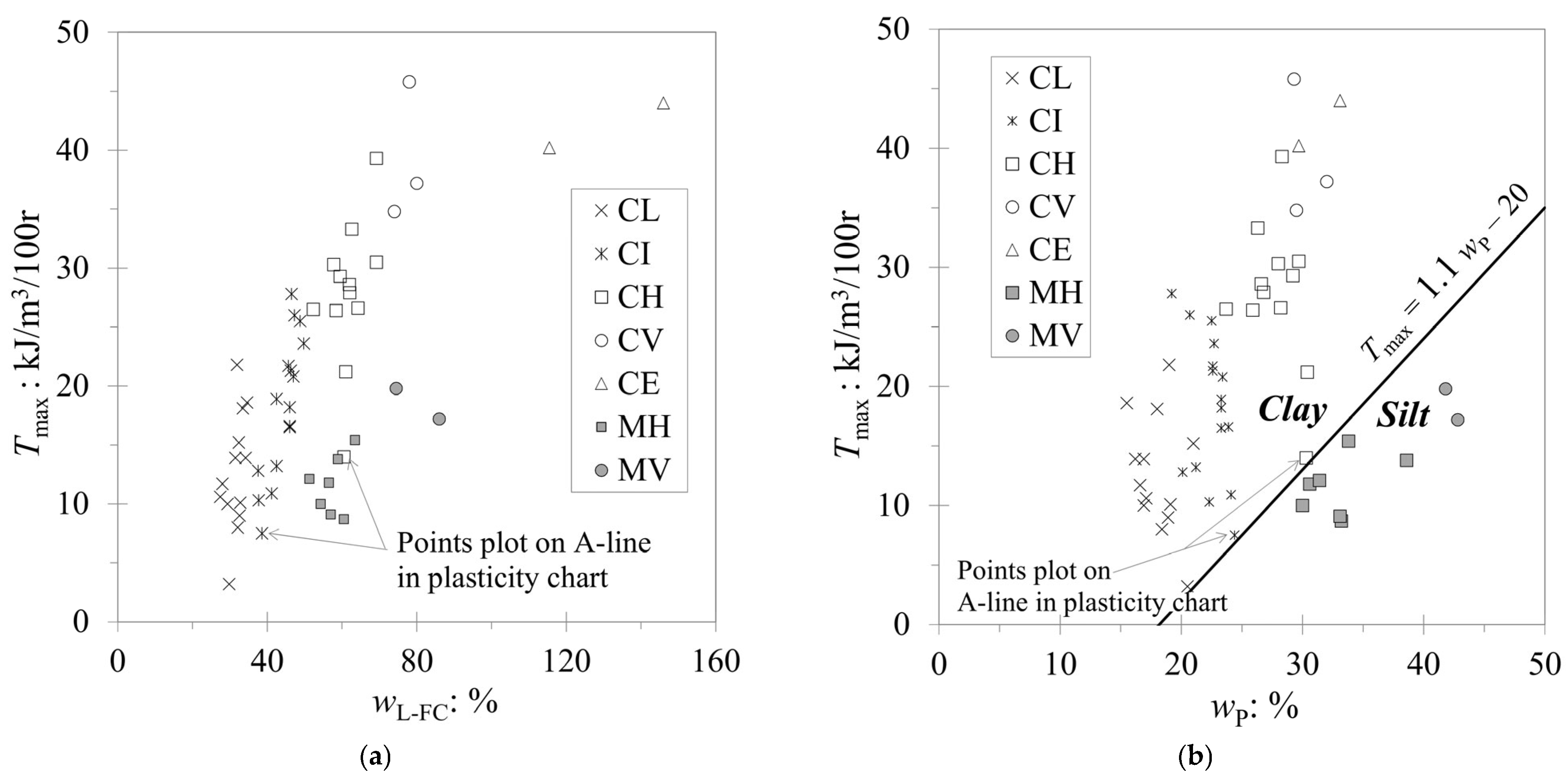
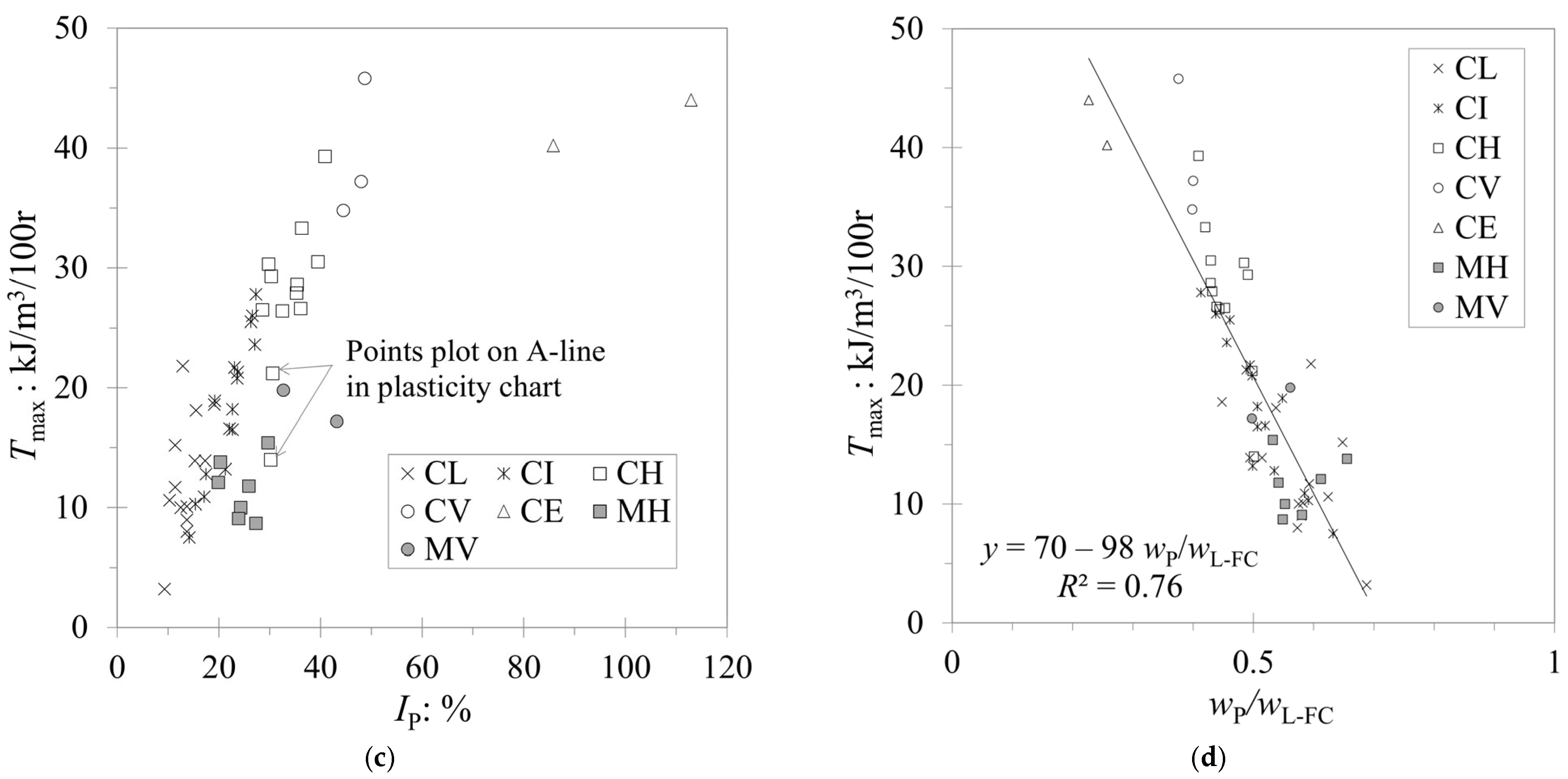
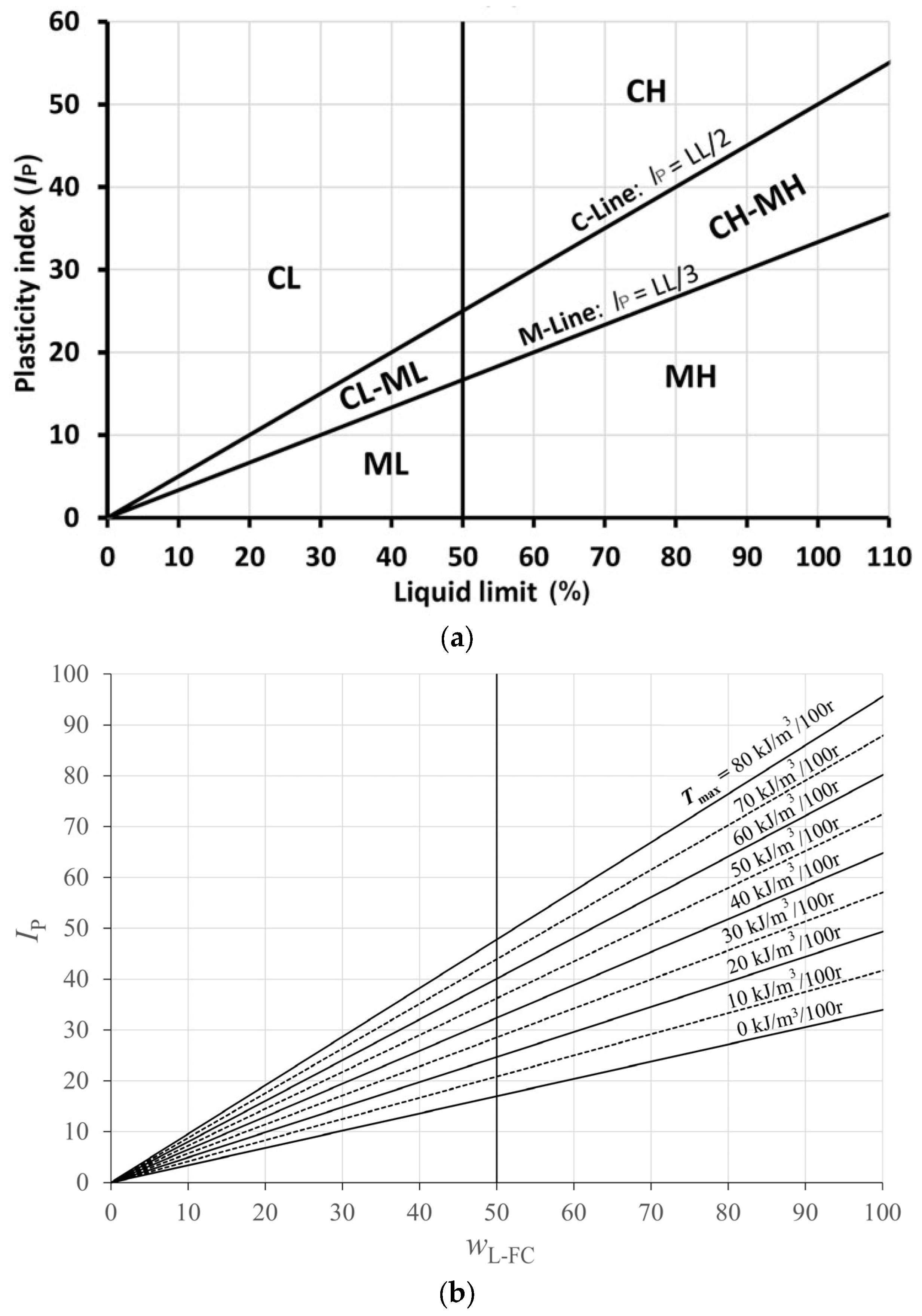
| Toughness Classification | Tmax (kJ/m3/100 r) |
|---|---|
| Very low | <5 |
| Low | 5–10 |
| Moderate | 10–20 |
| High | 20–30 |
| Very high | 30–50 |
| Extremely high | >50 |
| Method | Type | Advantage | Weakness |
|---|---|---|---|
| Manual thread rolling [3,4,41] | Direct | Meets original definition of toughness. | Qualitative (does not allow obtaining numerical values). Subjectivity; high operator dependence. |
| Barnes’ thread rolling apparatus [8,17,18] | Direct | Meets original definition of toughness. Objectivity (mechanically determined). | According to [50]: relatively complex measurement approach; slowness (many experimental points required); great skill on operator’s part to reach value of Tmax. |
| Extrusion [12,13,46,47,48,49] | Indirect | Objectivity (mechanically determined). Good correlation between extrusion resistance and toughness [12,13,46,47]. | Non-standardized (features of extruder device and extrusion conditions may give different results). Equipment cost. |
| Estimation from consistency limits ([11], this paper) | Indirect | wL and wP obtained using standardized and widely known methods. Good correlation with Barnes’ values of Tmax. Speed and low cost. | Of the parameters associated with consistency limits, only the wP test meets toughness definition. Based on estimates according to statistical criteria, outliers may not fit estimated values. |
Disclaimer/Publisher’s Note: The statements, opinions and data contained in all publications are solely those of the individual author(s) and contributor(s) and not of MDPI and/or the editor(s). MDPI and/or the editor(s) disclaim responsibility for any injury to people or property resulting from any ideas, methods, instructions or products referred to in the content. |
© 2023 by the authors. Licensee MDPI, Basel, Switzerland. This article is an open access article distributed under the terms and conditions of the Creative Commons Attribution (CC BY) license (https://creativecommons.org/licenses/by/4.0/).
Share and Cite
O’Kelly, B.C.; Alonso-Azcárate, J.; Moreno-Maroto, J.M. A Comprehensive Review of Soil Remolding Toughness Determination and Its Use in the Classification of Fine-Grained Soils. Appl. Sci. 2023, 13, 5711. https://doi.org/10.3390/app13095711
O’Kelly BC, Alonso-Azcárate J, Moreno-Maroto JM. A Comprehensive Review of Soil Remolding Toughness Determination and Its Use in the Classification of Fine-Grained Soils. Applied Sciences. 2023; 13(9):5711. https://doi.org/10.3390/app13095711
Chicago/Turabian StyleO’Kelly, Brendan C., Jacinto Alonso-Azcárate, and José Manuel Moreno-Maroto. 2023. "A Comprehensive Review of Soil Remolding Toughness Determination and Its Use in the Classification of Fine-Grained Soils" Applied Sciences 13, no. 9: 5711. https://doi.org/10.3390/app13095711
APA StyleO’Kelly, B. C., Alonso-Azcárate, J., & Moreno-Maroto, J. M. (2023). A Comprehensive Review of Soil Remolding Toughness Determination and Its Use in the Classification of Fine-Grained Soils. Applied Sciences, 13(9), 5711. https://doi.org/10.3390/app13095711








